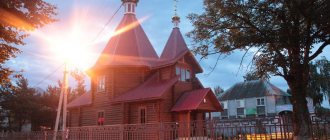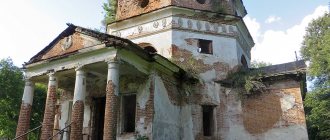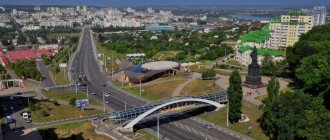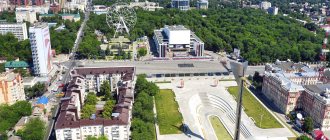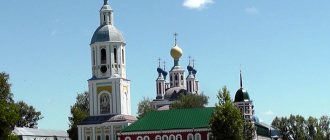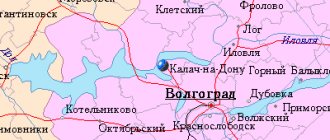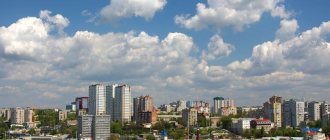From the editor: The history of the city of Dankov on the Don is still shrouded in secrets and replete with historical inaccuracies. The official founding date of Dankov has been set several times, and all of them are unfair.
The last date of formation, 1568, was imposed by the regional authorities; under its pressure, the year of formation of the city of Dankov was established (Before that, the dates were 1521 and 1523). I would like to hope that historical truth will prevail. Thanks to officials, Dankovites celebrated the 450th anniversary of the city twice, and this is from the realm of ignorance.
At least there is a document that mentions the year 1283. This letter contains a petition from the metropolitans of Kolomna and Ryazan to Tsar Ivan the Terrible, so that he would fairly judge the belonging of the Donkovo lands to the Kolomna, or Ryazan diocese. The Ryazan Metropolitan was able to provide documents dating back to 1283, but the Kolomna Metropolitan had no evidence. That is, in 1283 and earlier Dankov (Donkov) already existed and owned land plots. This is confirmed by the chairman of the Dankovsky Society of Local History, Ivan Fedorovich Malyukov. In the film “Donkovo Cossacks - Rising from the Ashes,” which can be viewed on this page below, there is an interview with Ivan Fedorovich.
It is worth mentioning the name of the city. The letter “a” appeared in the name in the 18th century, during the reign of Catherine the Second. Apparently the queen, a German by nationality, wrote Dankov, not Donkov, in one of the documents. It is clear that the officials did not dare to contradict the empress.
The word Donkov itself appeared thanks to the merger of two languages, Turkic and Old Russian. In Turkic “Don” is a river, and “kov” in Old Russian is a bend. That is, Donkov is nothing more than a place at the bend of the river. Indeed, the Don has a bend in the shape of a horseshoe, both at the current location of the city and at the Streshnevsky settlement.
Let us recall that the existence of Turkic tribes dates back to the 3rd-4th centuries BC. e. These times were marked by great events, for example, the beginning of the construction of the Chinese Wall and when our ancestors the Scythians captured Asian Sogdiana.
Based on archaeological finds on the territory of the Dankovsky district, we can safely say that the city of Dankov is the most ancient in the region.
The only question that arises is the location of the foundation. It is not yet clear where the Donkov fortress originally stood, on today’s site, or on the Streshnevsky settlement, 40 km higher along the Don. Since the fortress burned more than once and the city “moved.” But this situation cannot be taken into account either. After all, if a person’s house burned down and he built it in another place, this does not mean that someone, for their own reasons, should change his last name and year of birth.
The antiquity of Dankov is confirmed by archaeologist A. Levenok’s excavations of the Dolgovskaya Neolithic site near the village. Long, Scythian and Sarmatian burials, near the city of Dankov. These are also tribes of the 3rd-4th centuries BC. e. This means that this area has been inhabited and provided everything a person needs for life since ancient times.
Evidence of the importance of Dankov, which stood on the road to ancient Byzantium, is medieval maps. We give as an example a map of the late 16th century, where there is Donkov, but there is no vaunted and supposedly “ancient” Yelets. By the way, according to chronicle documents, Yelets was built by Donkovo Cossacks, that is, Cossacks. There is plenty of evidence that the Cossacks originated on the Dankov lands and nowhere else, watch the film below.
The map can be viewed in high resolution at this
.
Dankov, this is the story of a small town, the fate of which is similar to other county and later regional centers.
Official history of Dankov
According to official statements, the city of Dankov was founded in 1568 and was originally located on the left bank of the river. Don 30 km from the modern city. Built to protect the southern borders from attacks by the Crimean Tatars, it played an important role in organizing the Russian guard service.
Burned in 1618 by Hetman Peter Sagaidachny, Dankov was revived the next year, but in a new place. The city took its modern location on the right bank of the Don at the confluence of the river. Vyazovnya. The Dankov fortress with four roadways and two blind towers was located on a hill, at the beginning of the modern street. K. Marx. In the fortress there was a wooden cathedral church in the name of the Nativity of the Blessed Virgin Mary, a governor's courtyard, a hut, a well, and a cellar for storing weapons. Around the fortress there were Storozhevaya, Streletskaya, Cossack and Pushkarskaya settlements. On the right bank of the river. Vyazovny, at its very confluence with the Don, stood the Pokrovsky Monastery. Over time, the city lost its military significance; its fortifications became dilapidated and began to be dismantled. One of the fortress towers existed until the beginning of the 19th century.
2 things to do in Dankov
- Go to the planetarium - it’s the only one in the entire region, and here at any time of the year you can look at the constellations of both hemispheres and the starry sky of different latitudes. It was founded in 1975 by a lecturer at the capital’s planetarium, Ivan Shevlyakov, who was born in Dankov. The scientist became famous for his revelations: several of his works are dedicated to charlatan ufologists; in the Dankov Planetarium in memory of his fellow countryman, he still gives a lecture to everyone on the topic “The Universe and UFOs.”
- Visit the “small Tretyakov Gallery” - that’s what the locals call their art gallery. It is located in the local history museum, which in turn is located in the Church of Dmitry of Thessalonica. The exhibition includes original works by Serov, Korin, Deineka, Grabar and other artists.
Dankov history of development
According to the plan approved by the Emperor on August 31, 1780, the city of Dankov developed in a westerly direction. The administrative part, represented by wooden buildings of public places, a prison hut and a prison building, was previously located between two stone churches: the Nativity of the Virgin Mary Cathedral and the Church of St. Demetrius of Thessaloniki, according to the plan, is moved behind the Demetrius Church. Opposite the public places it was planned to build a magistrate and a guest courtyard. The city, divided into quarters, increased its area due to the partial annexation of settlements. The modern central part of Dankov, enclosed between the Don, Vyazovnya and st. Zastavnoy, corresponds to the plan of 1780.
Pre-regular plan of the city of Dankov, 1780s.
The process of rebuilding the city was lengthy. The stone two-story building of public places (K. Marx St., 7) and the prison castle were built only in 1835. The place designed in the plan for bread and wine stores was built up with a two-story building in 1842 (it is currently part of the Dankov hospital ).
In 1864, the city had 4 state-owned and 326 philistine houses (17 of them stone), 5 streets and three squares: Drovyanaya, Gostiny Dvor and Khlebnaya. In 1861-1878. On Khlebnaya Square, construction was underway on a new two-story stone cathedral in the name of the Tikhvin Icon of the Mother of God. Occupying a vast area in the city center, the cathedral is the dominant high-rise volume in the surrounding space and is perfectly visible from long distances outside the city. In the second half of the 19th - early 20th centuries. in Dankov, other stone churches are being built and rebuilt - in the name of St. Demetrius of Thessalonica, Nativity of the Blessed Virgin Mary, St. George the Victorious, St. John the Evangelist and the Nativity of Christ, which also became the main high-rise and architectural dominants of the city.
The city of Dankov in the mid-19th century. Market Square (now V. I. Lenin Square)
Economically, Dankov was not rich. From the description of the city in the mid-19th century, compiled by the city mayor, merchant V.I. Ermakov, it follows that “all 71 merchant families hardly have cash capital and goods, with the exception of houses, more than 400 thousand rubles, and therefore the wholesale trade of merchants cannot be placed on a par with the cities surrounding Dankov.” The city's commercial and industrial enterprises included 3 slaughterhouses, in which up to 15 thousand sheep were slaughtered per year, 9 grain crushers and butter churns, and two candle factories, which produced up to 800 pounds of tallow candles. Wholesale trade in Dankov was carried out only in bread. All other types of trade were defined as “insignificant”1.
With the construction of the railway and elevator in Dankov in the 1890s. the importance of the grain trade increased. At the end of the 19th - beginning of the 20th centuries. stone two-story houses of wealthy merchants P.D. appear in the city. Goleva, A.M. Shumilova, A.P. Lebedeva, V.G. Popova. They are still an architectural decoration of the city.
Also of historical and cultural significance are buildings that previously belonged to educational institutions: a state-owned men's gymnasium (now a children's art house and a planetarium), a private women's gymnasium and a higher city primary school (in Soviet times - a medical school), a religious school, which was located until 1870. in the Pokrovsky Monastery, and then in a specially built building (now secondary school No. 1).
Dankov
Foundation of the city, Dankov Fortress
The name of the city Dankov (Donkov) comes from the Don River, along the picturesque banks of which the city is located.
Dankov is one of the oldest cities in the Upper Don region. In 1993, on the high left bank of the Don, near the village of Speshnevo, an obelisk stone was erected with the inscription: “Here until 1521 the border fortress of Dankov stood.” According to many researchers, this ancient Slavic settlement of the pre-Mongol era was the predecessor of the modern city of Dankov. The fortress had not only defensive significance; navigation along the Don began from here. In 1521, the settlement was completely destroyed and burned by the hordes of the Crimean Khan Makhmet Giray. The ancient ruined city with the name Donkov is also mentioned by the German diplomat and traveler Sigismund Herberstein, who visited Russia twice in the first half of the 16th century.
42 years later, in 1563, Ivan the Terrible issues a decree on the construction of the Dankovo fortress. But the fortress was not built on the ashes of old Dankov, but 30 kilometers to the south. It was surrounded on all sides by forests. The Don and Vyazovnya rivers were reliable protection. Numerous clashes with the Crimean and Nogai Tatars took place here. Surrounded by wooden walls, the city with its advantageous strategic position more than once became an insurmountable obstacle to foreign hordes. In memory of the heroic past, a marble obelisk was erected in Dankov with the inscription: “Eternal memory and glory to the defenders of the southern borders of the Russian state of the 16th–17th centuries.”
Over time, the borders of the Russian state move further to the south, and Dankov loses its significance as a fortress. The fortifications deteriorate, Dankov becomes an ordinary provincial town. The service people founded settlements and began farming. The settlements had their own churches: in the Storozhevoy Sloboda - the Nativity of Christ, in the Pushkarskaya Sloboda - Pyatnitskaya, in the Cossack Sloboda - Nikolskaya (Georgievskaya) and St. John the Theologian, in the Streletskaya Sloboda - the Church of Demetrius of Thessaloniki. Initially, all churches were wooden. The first stone Dimitrievskaya Church was built in Streletskaya Sloboda in 1760, now it houses a local history museum. However, in the military history of Russia the city still played a significant role in its different periods. When the Russian fleet was emerging, “high-quality and high-speed plows” were built in Dankov, and the best craftsmen of the city built sea ships on the Voronezh ropes. Large consignments of ships for the Russian fleet, whose origins were Peter I, were supplied by the Romanov shipyard, which was located in the second half of the 17th century in the Dankovsky district.
Dankov - district center of governorship
In 1778, Dankov became the district center of the Ryazan governorship, remaining in this status for 150 years. There were 39 stone buildings in the city. In 1787, a public school was opened - the first and only public school in the city and county. In 1804, a district school was opened, in 1814 - a two-class city theological school.
In 1791, there was a strong fire in Dankov, which destroyed a large number of wooden buildings. After the fire, the city began to be built up according to a regular plan, which included a rectangular grid of streets oriented to the cardinal points. The old part of the city has preserved the features of that building even today. One-story houses were mainly built of wood. The first floors of two-story buildings, as a rule, were built of stone, and the second floors were built of wood. The administrative and commercial center of Dankova was finally formed at the end of the 19th century.
According to the “List of populated places in the Ryazan province” for 1862 (according to information from 1859), Dankov is a district town in the Ryazan province, located 1019 versts from St. Petersburg, 167 versts from the provincial city of Moscow. In Dankov there are 308 houses and 1496 residents - 753 males and 743 females. The city has 2 Orthodox churches, a district and parish school, a hospital, a postal station, and 2 fairs.
On August 16, 1861, construction began on the Tikhvin Cathedral on the site of the miraculous discovery of the icon of the Tikhvin Mother of God. The two-story, six-altar church with a five-tier bell tower was built in the traditions of Russian-Byzantine architecture.
In 1890, a railway was built through the city - a section of the Ryazan-Ural Railway. On November 18, 1890, the first train arrived in Dankov, opening traffic on the Ranenburg – Astapovo – Dankov section. The establishment of railway communication resulted in increased trade. The city was famous for its fairs. In the center of Dankov there were shopping arcades and a market square where they sold bread, handicrafts, goods of merchants and horses. It is no coincidence that the horse entered the symbolism of the coat of arms of old Dankov. By the end of the 19th century, the city became a major center for the grain trade. In 1890, the construction of an elevator with a capacity of 200 thousand poods was completed.
In 1909, the Vinogradova women's gymnasium opened. Merchant estates were located on Moskovskaya Street; all trade was concentrated here. Nearby there were administrative buildings built according to a standard design of the first half of the 19th century. A fire tower towered above the ordinary buildings.
The city after the October Revolution of 1917
On the eve of the 1917 revolution, Dankov had about 4,800 inhabitants. There was a zemstvo hospital in the city, a four-year primary school, 2 secondary educational institutions, a state-owned men's and private women's gymnasium. The city had a library, a noble-merchant club, and a small cinema. There were 23 industrial and craft establishments, mainly processing agricultural products. A common craft was stone quarrying. There were no large industrial enterprises in the city.
When zoning in 1924, the center of the county was moved to Ranenburg. In 1926, Dankov lost its city status and became a village. In 1928, Dankov became the center of the Dankovsky district within the new territorial boundaries. From this moment on, industrial construction intensified in the city.
In the 1930s Drying and potato processing plants began operating. In 1932, the Moscow-Donbass Railway opened a crushed stone plant on the outskirts of the city. Since 1935, the inter-district office of the Glavpischeprom trust functioned. In 1936, the district food processing plant began producing products, and in 1937, the creamery and cheese factory. At the end of the 1930s. construction of one of the country's first plant rubber plants begins - on December 23, 1940, the plant produced its first products.
In 1941, Dankov received the status of an urban village.
With the beginning of the Great Patriotic War, the lives of the residents of Dankov were completely devoted to supporting the front. On July 4, 1941, a rally was held on Lenin Square, in which 2 thousand Dankovites took part. In August 1941, the headquarters of the Dankovsky fortified area was located in the building of the district executive committee on Uritsky Street, house 36. The head of the fortified area was Lieutenant Colonel Lomachinsky. The headquarters developed maps for the construction of defensive structures throughout the fortified area. The entire population of Dankov took part in the construction of defensive fortifications. The main activity took place along the left bank of the Don River. Anti-aircraft installations were placed in the city in such a way that an aircraft approaching from any direction would come under barrage fire.
Workers worked almost around the clock in factories producing weapons, equipment, clothing and shoes for soldiers. Hospitals from the front-line areas were evacuated to Dankov. Dive bombers PE-2, TU-2, and fighters accompanying Soviet heavy bomber aircraft were based at the Dankovsky airfield.
On January 1, 1946, the population of the district was 24,255 people, Dankov - only 1,970. Dankov remained a workers' village, uniting 69 collective farms, 3 state farms and 14 rural Soviets.
In the post-war years, the city's industry began to develop rapidly. The crushed stone plant is operating at full capacity. In 1953, it was converted into a chemical one and became a union-scale enterprise, the first-born of organosilicon chemistry in the country. Within a short period of time, a hydroelectric power station with a capacity of 750 kilowatts was built and put into operation in Dankov.
On February 17, 1957, the city of Dankov regained its city status. Since 1959, large cultural and housing construction began in the city: new schools, shops, hospitals, and a high-water bridge across the Don River were built (1961). Precast concrete and starch plants, a poultry plant, the Cosmos clothing factory, a dairy plant, and a bread factory were put into operation. New blocks of multi-storey residential buildings have been built on the left bank of the Don.
Today Dankov is a diversified city, the center of the Dankovsky district. As of January 1, 2012, the city's population was 20,652 people.
About the pogroms committed by the Cherkasy army of Hetman Peter Sagaidachny in the cities of Mikhailov and Stary Dankov. The arrival of the Tatars near Dankov. Construction of a new Dankov on the Vyazovsky settlement.
Summer 7130 July on (date omitted) the day of the Tsar Tsarev and Grand Duke Mikhail Fedorovich of All Russia decree the memory of the boyar Prince Ondrei Vasilyevich Sitsky and Yakov Mikhailovich Boborykin and clerk Ivan Gryazev. In the memory of your Ondreev’s note it is written: I was ordered to write to you in the Cross Order.
Fyodor Grigoriev, son of Oladin, was a governor in Mikhailov in the past in 126 and was sent to Donkov. And that his service to the sovereign was investigated (letters missing) and in Rozryad in the past in 126 in July, Fyodor Oladin was sent to the sovereign's service in Donkov as governor. And on the 26th day of September 126, Fyodor Oladin wrote to the Tsar and Grand Duke Mikhail Fedorovich of All Russia: in the past, in 126, by the sovereign's decree, he was ordered to be in the sovereign's service in Donkovo. Yes, with him, for the siege, a potion and lead were sent from Moscow to Donkov and how he would be on the fire (unknown word) and the news came to him that the hetman of Saydachna Donkovskaya prison was taken and burned.
And he, Fyodor, with the sovereign's and lead treasury, turned to Mikhailov and came to Mikhailov. Before the arrival of Hetman Saydachnovo and the Lithuanian people. And on the 16th of August, Hetman Saydachnoy from Cherkasy arrived near Mikhailov. And he, Fyodor, with the Mikhailovsky governor Stepan Ushakov, sat on Mikhailov under siege from the Lithuanian people. Stepan is at the Litovskie Gate, and he, Fedor, is at the Pyatnitskie Gate.
And on the 19th day of August at the fourth hour of the day, Hetman Sajdachnoy and all the people began violent attacks on the city and the fort, day and night, without ceasing, and swept a wooden mountain towards the coal tower and set fire to the coal tower.
And he, Fyodor, went out with the military men and, by God’s mercy and the sovereign happiness of the Lithuanians, they beat many people and captured many alive. And he, Fedor, in that battle with his people Stepank Olekseev and Sereshka Stepanov killed twelve people. Yes, on the 23rd day of August, Hetman Saydachnoy with all his people came to Mikhailov with a squad and with tours, and they attacked the city all night from all sides, without ceasing, with cruel attacks. And he, Fyodor, with the military men from the city went out to the front. And during the outing, many Lithuanian people were... caught and... the signs were burned in the ditch. And he, Fedor, in that battle killed two Cherkashenin men, shot a man, and killed their horse on the spot near Fedor. Yes, his people behind him - Stepanko Olekseev, Sereshko Stepanov - killed three men. And his man, Stepanka, was killed by the Cherkasy in that battle. And the potion and lead that were sent with him and Fyodor to Donkov - and that potion and lead to Hetman Saydachnovo and Cherkasy came to Mikhailov, all went to waste, because at Mikhailov there was no potion and lead in the first attack. And with that Donkov potion and lead, the city of Mikhailov was defended. And how the Cherkassy moved away from Mikhailov and Fyodor Aladin, by the sovereign's decree, was ordered to be in Donkovo as before. And build a fort in Donkovo and strengthen it with all sorts of fortresses.
And on the 28th day of November 127, Voivode Fyodor Oladin wrote to the sovereign that he arrived in Donkov on the 26th day of October and gathered all sorts of people from Donkov and built a fort on Donkovsky on the Old Settlement and fortified it with all sorts of fortresses. Yes, he found Donkov’s burnt outfit, which the Lithuanian people drowned in the river - two one-and-a-half-size squeaks, two mattresses and six Zatin squeaks.
Yes, on the 1st day of September 128, Fyodor Aladin wrote to the sovereign from Donkov: in the past, in the 127th of June, on the 8th day, a hundred or more Tatars came to Donkov. And he, Fyodor, with Donkov’s military men, came out of the prison and fought with the Tatars and beat many Tatars. And they beat the horses under them and, fighting near Donkov, the Tatars went along the Epifanskaya road.
Yes, on the 3rd day of August, about fifty or more Tatars came near Donkov from the Nagai side. And he, Fyodor, with his servants and all sorts of people, came out of Donkov and fought with the Tatars and beat the Tatars. And under the horses they beat the Tatars, fighting near Donkov, and went along the Ryaz road.
Yes, on the 7th day of August, about seventy or more Tatars came to Donkov. And there was a fight with those Tatars. And the Tatars fought and went to Ryazsky. Yes, on the 24th day of August, about vespers, about a hundred people or more came to the Streltsy and Cossack fields near Donkov. And he, Fyodor, with all the Donkov servicemen and the Zhiletsky people, came out of the prison and fought with the Tatars and in that battle killed the Tatar. And fighting, the Tatars went from Donkov along the Crimean side.
Yes, on the 24th day of September, Fyodor Aladin wrote to the sovereign from Donkov that on the 2nd day of September the Tatars came to Donkov... and about sixty people came to the Cossack fields to the settlement on both sides of the Don on the Crimean and Nagai sides. And he left the prison with Donkov’s servants and with the Zhiletsky people from the Tatars and fought near the village. And in that battle he killed two Tatars, and wounded others, and beat and wounded the horses under others.
Yes, on the 17th day of December, Voivode Fyodor Aladyim wrote to the sovereign from Donkovo, according to the sovereign's decree and by petition of all kinds of Donkovo servicemen and Zhiletsky people, he was ordered to withdraw the Donkovo fort from Donkovo Starovo fortification and the outfit and potion and lead and all sorts of cannon and grain reserves and transfer Donkovo servicemen to the Vezovenskoe fortification. And he was ordered to build a prison and fortify it with all sorts of fortresses, to dig wells and make hiding places, and to strengthen the prison with all kinds of fortresses. And he, Fyodor, set up a fort on the Vezovenskaya fortification and strengthened it with all sorts of fortresses and transported the outfit and potion and lead and all sorts of cannons from Old Donkov to the new fort in Vezovenskaya. And he transferred all sorts of people from Donkovo, and all sorts of Donkovo people settled in the new Donkovo on the Vezovensky settlement. And in the new one in Donkovo on the Vezovinsky settlement they dug wells and made hiding places to the river near Vezovenka and fortified the fort with all sorts of fortresses. And for that new Donkov, who was at the Vezovensky settlement, he arranged a drawing for every fortress, and sent the painting to the sovereign in Moscow.
Yes, on the 17th day of the Maya, the governor Fyodor Aladin wrote to the sovereign from Donkovo; on the 30th day of April, he, Fyodor, sent, according to Tatar news, a parcel to the Don to transport the Streletskovo foreman Savka Korolev, and with him the archers and Cossacks. And the foreman Savka Korolev came with his comrades to Donkov, and in question told him that on the 3rd day of May, at sunrise, about fifty or more people came to Donkov on Kobelsha to transport the Tatars. And he, Savka, fought with those Tatars on the transport and, by God’s mercy and the sovereign’s happiness, beat many Tatars. And underneath the horses they were injured.
How to get there and where to stay
The city of Dankov has a convenient geographical location in terms of transport accessibility: between two major highways M6 and M4. You can get to Dankov by turning off these roads onto P-126. From Lipetsk to Dankov there is Lebedyanskoye Highway, highway R-205.
From Moscow, buses regularly run here from the Paveletsky station and the bus station at the Shchelkovskaya metro station, as well as train No. 31 to Tambov (you need to get off at the Ranenburg station and take a commuter bus).
There are two hotels in Dankov: “Silan” at the chemical complex, but judging by the reviews, they are far from exemplary.
THE YEARS OF THE COUNCIL OF NARCHOSIS
View of the industrial zone of Dankov, photo by S.P.
Sinev Sovnarkhozy in the USSR is another revolution in the country, the abbreviation stands for the Council of the National Economy, that is, local managers who were involved in the development of the industrial and social sector. They worked under the control of deputies of the Council of Workers, Red Army and Peasant Deputies.
With the advent of N.S. Khrushchev to the leadership, new experiments began in industry, agriculture, and party building. On February 14, 1957, the Plenum of the CPSU Central Committee and the Council of Ministers of the USSR under the leadership of N. S. Khrushchev decided to create economic regions.
The entire country was divided into 105 economic regions, and accordingly 105 National Economic Councils (sovnarkhoz, SNK) were created, including the Lipetsk economic council. V. Ya. Klimenkov, who had previously worked as director of the Lipetsk Tractor Plant, was appointed chairman of the Economic Council.
Economic councils received more sovereignty and rights. The All-Union Council of National Economy (VSNKh) governed all economic councils. Within the framework of economic councils, opportunities for specialization and cooperation have expanded, and the organization of work on material and technical supplies has significantly improved.
During the seven-year period (1959 - 1965), the country's main production assets doubled! Labor productivity increased by 6.5 percent annually from 1960 to 1970. Historians note that this was the best figure in the last 30 years.
With the formation of economic councils, drastic changes began in the fate of local enterprises; a striking example is the Dankovsky crushed stone plant No. 15. And the whole of Dankov as a whole has undergone many changes.
Links[edit]
Cathedral of Our Lady of Tikhvin in Dankov
Notes[edit]
- ^ abcdefgh Law No. 382-OZ
- ^ a b Federal State Statistics Service (2011). “All-Russian Population Census 2010. Volume 1" [All-Russian Population Census 2010, vol. 1]. All-Russian Population Census 2010 [All-Russian Population Census 2010]
. Federal State Statistics Service. - "26. The size of the permanent population of the Russian Federation by municipalities as of January 1, 2021". Federal State Statistics Service. Retrieved January 23, 2021.
- ^ abcd Law No. 126-OZ
- Federal State Statistics Service. Federal Agency for Technological Regulation and Metrology. No. OK 033-2013 January 1, 2014 “All-Russian classifier of municipal territories. Code 42 609 ". (Federal State Statistics Service. Federal Agency for Technological Regulation and Metrology. No. OK 033-2013 dated January 1, 2014. Russian classification of municipal territories. Code 42 609.
). - "On the Calculation of Time". Official Internet portal of legal information
. June 3, 2011. Retrieved January 19, 2021. - Post office. Information and computing center of OASU RPO. ( Post office
).
Search for postal service objects ( postal Search for objects
) (in Russian) - ↑
Federal State Statistics Service of Russia (May 21, 2004).
“The population of Russia, the constituent entities of the Russian Federation as part of federal districts, urban settlements, settlements, settlements is 3 thousand or more people” [Population of Russia, its federal districts, federal districts, districts Urban settlements, rural settlements - administrative centers and rural settlements with a population of over 3,000] (XLS). All-Russian Population Census 2002
. - “All-Union Population Census of 1989. The current population of union and autonomous republics, autonomous regions and districts, territories, negative phenomena, urban settlements and rural district centers” [All-Union Population Census of 1989: current population of union and autonomous republics, Autonomous regions and districts , territories, regions, districts, urban settlements and villages performing the functions of district administrative centers. All-Union Population Census of 1989 [All-Union Population Census of 1989]
.
Institute of Demography of the National Research University: Higher School of Economics [Institute of Demography of the National Research University: Higher School of Economics]. 1989 - via Demoscope Weekly
. - Taurica Chresonesus, Nostra Aetate Przecopsca et Gazara dicitur
in
Atlas SIVE Cosmographicae Meditationes de Fabrica Mundi et Fabricati Fugura
(1596). - Russiæ, vulgo Moscovia, pars australis
in
Theatrum Orbis Terrarum, sive Atlas Novus in de Tabulæ et Descriptiones Omnium Regionum, Editæ a Guiljel et Ioanne Blaeu
, 1645.
